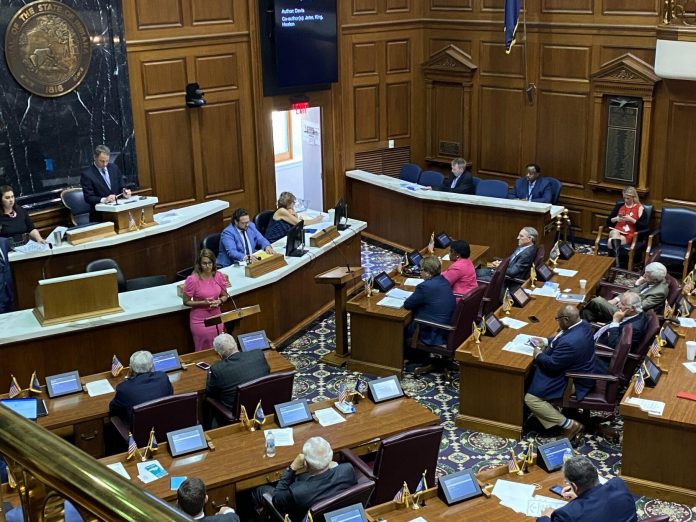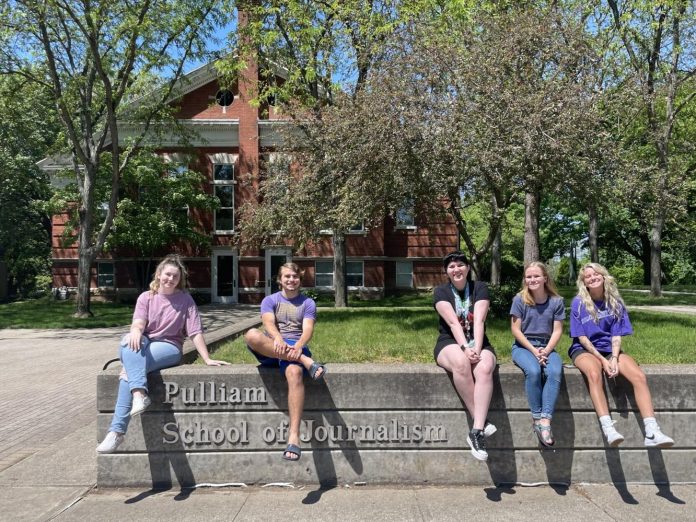Holcomb also pointed to the Indiana High School Athletic Association’s policy as proof that the legislation is unneeded.
The policy looks at cases on an individual basis, and IHSAA commissioner Paul Neidig said he only knows of two applications in the past 10 years. One was regarding a student who was transitioning to male and was allowed to compete on a male cross-country team. The other applicant, who was transitioning to female, decided against continuing to pursue the issue.
In both sessions, the governor’s veto was read aloud. Where they diverged was in what followed. While there was no debate in the House, the Senate spent over an hour talking about the bill.
Sen. Stacey Donato, R-Logansport, presented the bill and said it was important no matter if there were only one case. She also mentioned other states that have passed similar legislation.
Sen. J.D. Ford, D-Indianapolis, who spent much of his 30-minute-long speech speaking about Republicans like Holcomb and Utah Gov. Spencer Cox who oppose this and similar bills, responded to Donato by saying many of those laws are currently being challenged in courts.
Sen. Shelli Yoder, D-Bloomington, also spoke and asked if this was a worthy use of the Senate’s time.
“We are spending our time to make children feel bad about themselves,†Yoder said. “This bill is in no way a solution to a problem. It is a problem.â€
Before the sessions began, members of the public stood in lines outside the House and Senate chambers waiting to be admitted.
LaKimba DeSadier, state director of Planned Parenthood, said she was there to “hold our legislators accountable.â€
“We just want them to be accountable and truly represent their community,†DeSadier said.
John Lapp, who has a transgender child, said, “I feel very strongly that this is a hateful bill.â€
“Everyone’s a human,†said Natalie Auberry. “It goes against my values to discriminate like this.â€
She continued: “You know, I was very happy to see, personally, that there are more people here on this side of the issue than on the other side.â€
A recent survey by American Principles Project, a conservative think tank, suggests that when it comes to Hoosiers overall, they do support the bill.
In a survey of around 1,000 likely voters, 64.5% said they would “support legislation that banned biological male students that identify as transgender girls from competing in girls’ sports programs at Indiana K-12 public schools. Some 53% disapproved of Holcomb’s veto.
Seven Republicans split with their party to vote to uphold the veto. They were Rep. Ed Clere, R-New Albany; Rep. Tom Saunders, R-Lewisville; Rep. Cindy Ziemke, R-Batesville; Sen. Ron Alting, R-Lafayette; Sen. Phil Boots, R-Crawfordsville; Sen. Ed Charbonneau, R-Valparaiso; and Sen. Greg Walker, R-Columbus.
City-County Observer Footnote: Area Lawmakers who voted to override the governor’s veto to protect the integrity of the “Trans” Athlete Bill in Indiana were TIM O’BRIEN (R), WENDY MCNAMARA (R), MATT HOSTELLER (R), AND CINDY LEDBETTER (R). Â The lone area Democrat who voted not to overturn the Governor’s veto was RYAN HATFIELD (D).
At press time we had a problem verifying how Indiana State Senators Becker (R) and Toomes (R) voted on this issue but shall provide our readers an update once we find the results.





 From left, Ashlyn Myers, Isaac Gleitz, Ari Lovitt, Taylor Wooten and Maddie Alexander pose outside Shirk Hall on the Franklin College campus, home to the Pulliam School of Journalism. The five reporters just finished a successful stint at
From left, Ashlyn Myers, Isaac Gleitz, Ari Lovitt, Taylor Wooten and Maddie Alexander pose outside Shirk Hall on the Franklin College campus, home to the Pulliam School of Journalism. The five reporters just finished a successful stint at 





